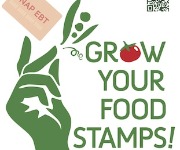A few years ago, back when she still had a job in the natural-foods industry, “my kids only got the best in terms of food,” said Corbyn Hightower, a mother of three who now lives outside Sacramento. Then, she said, “we lost everything, and we really started having to compromise.”
Hightower signed up for the federal Supplemental Nutrition Assistance Program (SNAP), or food stamps. When she looked through the information pamphlet she received, she found out that SNAP benefits can be used to buy seeds and plants, not just food. So she went to Whole Foods, bought some seeds, and planted a garden of salad greens. “It was one of the things I could do that made me feel like my kids weren’t going to have to let go of [eating well],” she said.
Unlike Hightower, most SNAP recipients are not aware of this alternative use for their electronic benefit transfer (EBT). “I’m really proactive about obtaining information, so maybe that helped,” she said. “I’m not the typical EBT customer, although I’m sure there are a lot more like me now — people who always shopped at the perimeter of the stores and bought organic.”
This detail of our federal food-stamp program flies under the radar of many people active in food-justice and urban-farming circles, too. Daniel Bowman Simon, a graduate student and garden advocate, didn’t know of the provision until 2008, when someone mentioned it to him during a chance encounter at a farmers market.
“The more people I talked to who thought it was a good idea but didn’t know about it themselves, the more I thought, well, somebody’s got to start a project to make sure that people on food stamps get this information,” Simon said. Earlier this year, he founded the nonprofit SNAP Gardens to spread the word about this oft-overlooked aspect of the SNAP program, which was added as an amendment to the Food Stamps Act in 1973 by Sen. James Allen (D-Ala.).
Simon pointed out that 46 million Americans use food stamps (nearly 15 percent of the U.S. population), so “just raising that awareness alone is a huge undertaking.”
SNAP Gardens prints cheerful posters in several languages advising SNAP recipients that they can use their benefits for seeds. Simon said he’s gotten requests for the posters from farmers markets in 24 states and Washington, D.C. (While it’s becoming more common knowledge that EBT can be used to purchase food at farmers markets, many vendors are still unaware that they work for seeds and plants, too.) The posters are also designed to be displayed in local SNAP offices, community centers, or public housing locations. SNAP is a federal program, but administered locally, Simon explained, so local governments have more power to spread the word about different ways it can be used.
As an organic enthusiast but inexperienced gardener, Hightower admitted her first few seasons were hard. “[Gardening] takes luck and a lot more knowledge than I went into it with,” she said. “I know other people who use SNAP and they live in apartments or are working two jobs. [Gardening with SNAP benefits] is not everything it’s cracked up to be.”
Simon acknowledged this. “Seeds and plants alone don’t make a garden,” he said. “It takes time, it takes skills, it takes land. How do you connect people to resources to make [gardening] a choice that has real potential?”
An online resource called SNAP-Ed Connection offers training and education materials for SNAP providers who want to give would-be gardeners more guidance and support. But “not many states are doing much in the way of gardening education for SNAP recipients,” Simon said. He gets inquiries from master gardeners interested in working with food stamp recipients in their communities, and if the ground-up progression of the urban farming movement so far is any indication, that kind of grassroots, volunteer-powered education may be a better way to get EBT users started gardening than waiting on government offices to provide training.
With the help of a $1,000 microgrant from Awesome Food, SNAP Gardens will start working with The Dinner Garden — which sends out free starter packs of seeds by request — to set up a telephone hotline with gardening information. (Simon said that Dinner Garden founder Holly Hirshberg didn’t know about using SNAP benefits for seeds until he told her.) Part of the grant will also pay to include a flyer about using EBT for seeds with every packet The Dinner Garden sends out, with the assumption that many of those requesting free seeds might also be eligible for SNAP.
Hightower said her garden doesn’t offset her grocery budget dramatically — it produces maybe five dollars’ worth of salad greens a week. But using her SNAP benefits to garden is worth it for other reasons. “It makes me feel good, like I’m holding onto my values,” she said. “My kids know that going out and picking your greens is normal; it’s part of our family’s culture. Just because you’re poor doesn’t mean you can’t have this for yourself.”



